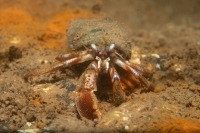
(Photo: Claire Goodwin)
Acadian Hermit Crab
Pagurus acadianus
This large hermit crab has a carapace up to 3 centimetres long. Its large claw is wide with a broad orange stripe. Rather than making their own shell, hermit crabs live in discarded sea snail shells.
Authority
Benedict, 1901
Classification Details
Phylum: Arthropoda (arthropods); Subphylum: Crustacea (crustaceans); Order: Decopoda (decapod crustaceans).
Habitat
Sometimes found in tidepools but usually only subtidal, on a variety of seabeds. Found on the east coast of North America, from the Arctic to Chesapeake Bay.
Diet
Scavengers. Eat a wide variety of food including worms, small crustaceans, tiny molluscs, scraps of dead animals, and algae. They scoop or scrape up food with their claws and transfer it to their mouths.
Reproduction
Hermit crabs can be male or female. Males will carry females around for several hours before mating. The female then carries the fertilized eggs on her body for 1 to 2 months before they hatch. She may have around 200 to 300 eggs. When they hatch, the larvae spend around a month and a half in the plankton before changing into small crabs and moving to the seafloor. The young crabs then have to find suitable shells to live in. Hermit crabs live for around four years.
Fun Facts
Hermit crabs don’t make their own shell but live in the discarded shells of sea snails. They have to move into larger shells as they grow. Crabs often fight over the most desirable shells. The crab tries to frighten its opponent out of its shell by rapping on the shell with its claws. Often the crab who raps loudest wins.
References
Briffa M and Elwood R (2000) The power of shell rapping influences rates of eviction in hermit crabs. Behavioral Ecology 11, 288–293. 10.1093/beheco/11.3.288. Grant WC (1963). Notes on the ecology of Pagurus acadianus. Ecology 44, 767–771. Lancaster I (1988). Pagurus bernhardus. An introduction to the natural history of hermit crabs. Field studies 7, 189–238. Lancaster I (1990) Reproduction and life history of the hermit crab Pagurus bernhardus. Journal of the Marine Biological Association of the United Kingdom 70, 129–142. Pohle G (1990) A guide to decapod crustaca from the Canadian Atlantic: Anomura and brachyura. Canadian Technical Report of Fisheries and Aquatic Sciences 1771.

